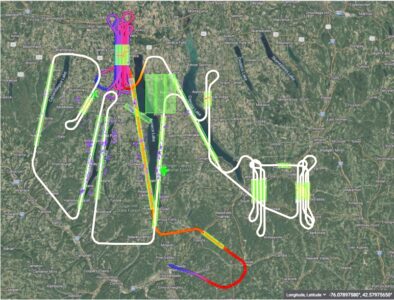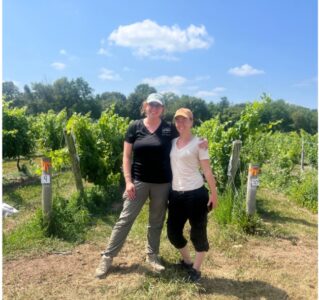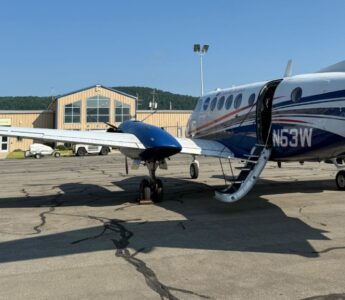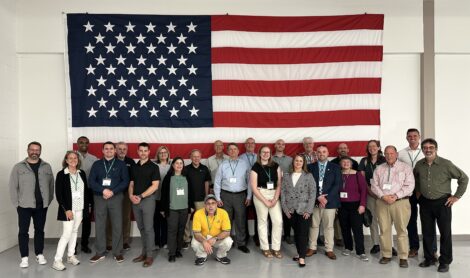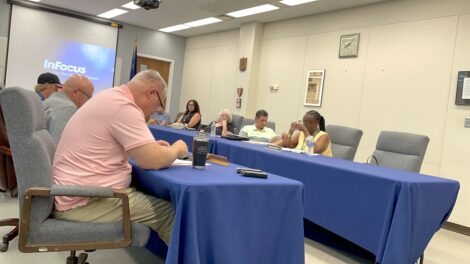‘Eye On The Sky’
Regional Grape Program Participates In NASA Imaging Flights Of Finger Lakes, Lake Erie Region Vineyards
- Pictured is the flight path taken by AVRIS-3 over the Finger Lakes region. Submitted photo
- Drs. Katie Gold (left) and Dana Chadwick (right), AVIRIS4Acres campaign lead project investigators, pictured at the Cornell Pathology Vineyards in Geneva, NY during an AVIRIS3 overpass. Submitted photo
- N53W with AVIRIS3 mounted inside, pictured at Elmira airport with a gorgeous blue sky prior to acquisitions. Submitted photo

Pictured is the flight path taken by AVRIS-3 over the Finger Lakes region. Submitted photo
A partnership between NASA and Cornell Cooperative Extension could help grape growers better manage their crops.
At the end of July, Cornell Cooperative Extension’s Lake Erie Regional Grape Program participated in a project with NASA ACRES for AVRIS-3 Imaging Flights in order to help better detect diseases in grape plants and vineyards.
On Monday July 28, AVIRIS-3 successfully captured high resolution hyperspectral imagery over Cornell University and USDA-ARS research farms in Geneva, Harford, Aurora, Ithaca and Freeville. In addition, high quality imagery was successfully captured over commercial grapevine, apple, and onion production in the Finger Lakes region.
The flights were funded by the NASA Agriculture program office in support of doctors Katie Gold and Yu Jiang’s NASA ACRES consortium funded research project on early disease detection. Cornell University is the largest sub-award in the NASA Acres consortium led by Dr. Alyssa Whitcraft at the University of Maryland-College Park.
The AVIRIS team generated a real time data product to quickly share crop insights with the Cornell and local specialty crop production community. Flights were inspired by conversations held between stakeholders, researchers, and members of NASA leadership at listening sessions held during a three-day “#Space4AgNY” tour of Cornell University research farms, FLX, and Lake Erie grape production in August 2024. Those discussions helped improve NASA Earth Science’s research portfolio in specialty crop agriculture and viticulture and led to more discussion of how to turn research into practice.
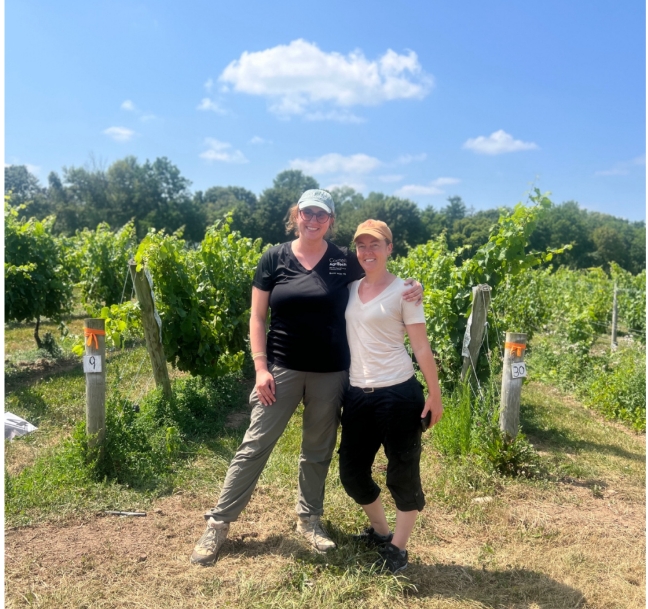
Drs. Katie Gold (left) and Dana Chadwick (right), AVIRIS4Acres campaign lead project investigators, pictured at the Cornell Pathology Vineyards in Geneva, NY during an AVIRIS3 overpass. Submitted photo
Drs. Dana Chadwick, Phil Townsend, and Henry Frye collected crop trait data to contribute to the VSWIR PLANTS database. These data will be used to generate downstream foliar trait maps to better understand crop physiology and impacts of disease development and management on grapevines. Cornell Cooperative Extension Finger Lakes Grape Program helped coordinate grower contributions to this dataset. Drs. Yun Yang, Louis Longchamp, Kerik Cox, Luke Gregory, Ying Sun, Mike Gore, and Sara Emery also deployed extensive ground validation efforts to leverage these data for ongoing thermal remote sensing, agronomy, apple pathology, and entomology research.
More imagery is slated to be collected over CLEREL and commercial grapevine production in Lake Erie over the next two weeks. If the opportunity presents itself, further captures of the AgriTech farms will be made.
Lead Cornell Researcher on the project, Katie Gould, said this work took “a lot of coordination” including 7:30 a.m. calls, and other coordination work, including securing funding, for months. The research involved will allow for the ability to better detect diseases in grape crops that farmers in these areas struggle with most, and has been previously used in California.
Work included scoping out the lines of vineyards being looked at, preparing regions, capturing imaging of the Finger Lakes and Lake Erie regions, and meetings to help researchers use the collected data from the imaging flights.
Gould said her work specifically looks at early disease detection in grapes and for some of her colleagues it will help map out areas to look at overall grape vine health.
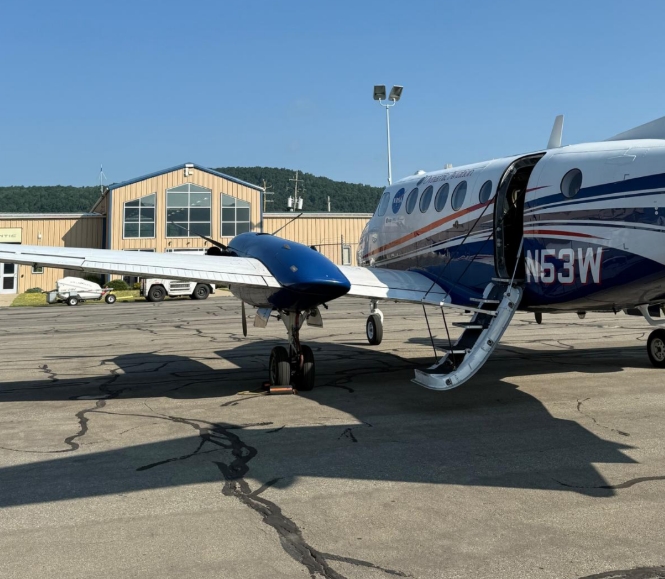
N53W with AVIRIS3 mounted inside, pictured at Elmira airport with a gorgeous blue sky prior to acquisitions. Submitted photo
“Airborne visible-shortwave infrared imaging spectroscopy is rapidly becoming the missing link between on�’farm sensing and forthcoming satellite missions,” Gould said.” NASA AVIRIS-3 flew over Cornell and USDA-ARS research farms as well as nearby commercial vineyards and orchards in July 2025 as part of NASA Acres’ ‘AVIRIS4Acres-NY,’ campaign. The instrument captured detailed fingerprints of every plant, allowing scientists to spot disease and nutrient stress before the human eye. Interactive maps were shared online within minutes so growers could zoom in on their farms and problem areas. By matching the images with hundreds of leaf samples, the team is building AI/ML based models to warn growers of stress earlier and guide smarter management intervention. Our project shows how pairing stakeholder input with cutting-edge imaging can turn NASA data into day-to-day decisions for specialty crop growers.”
The imaging over the Finger Lakes region has been completed, with the imaging in the Lake Erie region still to come. Gould said right now they are prioritizing the Lake Erie Region, but hope to swing back to the Finger Lakes and also up the East Coast and Atlantic Region.
“People should keep an eye on the sky and we will be sending out more information when the imaging flights are happening in the Lake Erie region,” Gould said. “People can also stay engaged with us to learn more about the data we are collecting.”
Everyone involved in this project are as follows: Kaitlin M. Gold, K. Dana Chadwick, Yu Jiang, Phil Broderick, Shivranjani Baruah, Manushi B. Trivedi, Henry Frye, Philip A. Townsend, Yiyuan Lin, Timothy Williams, David Combs, Cole Regnier, Caroline Kamal, Hannah Grover, Niko Carvajal Janke, Lorenzo Pippi, Hans Walter-Peterson, Terry Bates, Jennifer Russo, Yun Yang, Louis Longchamp, Kerik Cox, Luke Gregory, Ying Sun, Mike Gore, Sara Emery, Madeline Oravec, Jason Londo, Clayton Schmith, Christine D. Smart, Faith Twinamaani, Andre Garcia, Courtney Herzberg, Hadley Oleacrzyk, Alison Bredder, Mike Humber, and Alyssa Whitcraft.
Funding for the imaging flights project was provided by the NASA Earth Science Jet Propulsion Lab.

